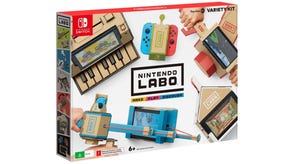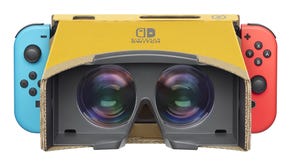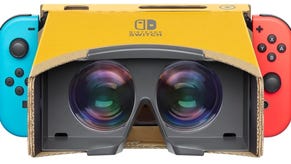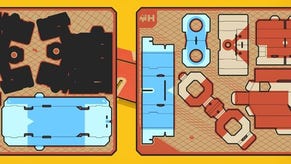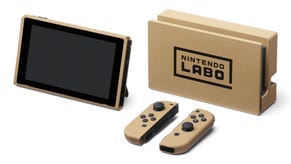Nintendo Labo review - an ingenious and generous cardboard triumph
Excitement in crease.
There's been a cardboard explosion. Some kind of arts & crafts volcano has erupted in my home and spewed detritus everywhere. I can't move for tiny bits of cardboard sticking to my feet, hitching a ride into other rooms, and I've got a pile of discarded cardboard templates this high to try and ram into a shared recycling bin. Woe is me. My vacuum will never suck this lot up. Why did I bother with Nintendo Labo?
"Oh, Dad! I found another one."
I remember. That's my son, he's seven and he's really into Fortnite and beating my sofa up. But right now he's sitting quietly, holding a cardboard house we built, diligently testing cardboard plugs to try and discover a new combination, because when he does, he discovers a new mini-game he can play with the monster on the Switch screen. It's heartwarming.
Yesterday it was his hilarious screaming I remember while he tried to hook a shark with our cardboard fishing rod we'd made, or his not realising he was humming the recorded tunes our cardboard piano played. Days earlier it was the wonder in his eyes while test-riding our motorbike, our first proper Labo build. But most of all I remember him stomping around wearing a big cardboard backpack and visor, yanking pulley chords on hands and feet to provide the motions for a giant robot on screen. It was like Godzilla made on Blue Peter, and it was magic.
Nintendo Labo, Nintendo's latest wacky invention, comes in two varieties and neither are cheap. There's a Variety Kit for £60 and a Robot Kit for £70, and inside each box are stacks of cardboard templates, accessories like rubber bands and plastic eyelets, and cartridges with bespoke games instructions and other apps on. The Variety Kit offers a variety of things to build: the motorbike, the house, the piano, the fishing rod, and an RC car which is basically an oversized Hexbug. Don't ask. In the Robot Kit, meanwhile, there's a robot kit (quite literal is Nintendo).
You build each Toy-con, as they're called, from shapes popped out of several organised sheets of colour-coded templates, following chirpy and encouraging instructions on the screen. Every fold and tuck is animated, accompanied by upbeat music, and you can rewind and change the angle if you're unsure about what to do. It's friendly and easy-to-follow and it needs to be because builds can take a long time - two hours or more. Labo frequently encourages you to take breaks, though, and even split construction over two days.
When you're finished, the final step is always slotting the Nintendo Switch hardware into the cardboard creation to bring it to life. Sometimes you use both Joy-cons and the screen, sometimes a mixture. Then you get to play whatever game has been designed for the toy. With the motorbike there's a modified version of Mario Kart, for instance, and with the robot you smash a town and UFOs up.
Some games are meatier than others - the motorbike game stretches across multiple courses and speeds, whereas the piano game is only really making sounds on a piano - but there's a second application to pad each toy's offering out. The piano comes with a recording studio, for example, where you can record and layer songs of your own, and even conduct them with cardboard baton holder for the other Joy-con. The robot comes with a versus mode and a challenge mode where you can unlock a handful of new moves. And the fishing rod has an aquarium where caught fish go, which is only part of the draw. You can also use the piano's scanning function - thin slices of cardboard slot in the top, you press a button and it scans, remarkably - to create your own fish from cardboard cutouts.
Scanning fish is an example of a deeper function you have to discover yourself. This constitutes the next layer of Nintendo Labo, which is finding out what extra things your toys can do. There's a Discover area where you can dig into these things and also discover how, exactly, the infrared sensors bring the toys to life (it's no less magical even when you know). Deeper still, you can explore the Toy-con Garage where you can get to grips with how the game programs the Joy-cons to work with each toy - and then reprogram them to your fancy.
In other words, there's depth. The Nintendo Labo slogan is "Make, Play, Discover" and this suggests just how much there is to do beyond folding the cardboard itself. In this way there's more longevity to Labo than you may think. Consider there are around 10 hours of building in the Variety Kit alone, and as many hours again playing with and exploring each toy - not to mention decorating them - and you've got something to last at least a few weeks (and be robust enough to withstand it).
But it's not necessarily how much time you spend with Labo which makes it special so much as how you spend the time with it. Gradually folding a bewildering pile of cardboard templates into a complicated and working toy is an absolute delight. Not only are Nintendo's ingeniously engineered inventions a joy to piece together - with many appreciative croons of "aha!", "ohh!" and "that's clever!" along the way - but doing so instils a mindful calm. I don't often get to build things so it feels like a nice accomplishment when I do, and smoothing each rough cardboard crease feels lovely, and the way the flaps pop and lock in place is enough to give me goosebumps.

Then there's the delightful moment that the creations come to life. Sometimes all it takes is one Joy-con and suddenly the robot is alive on screen or the piano is playable, and the Switch hardware is reinvented again. The toys simply work, it's amazing to behold - they have that Nintendo seal of quality in that way. (Although they do make a racket when in vigorous use, and the motorbike popped out of its base an annoying amount.)
By building something you also invest in it and care about it, and in turn it makes you more likely to go on and decorate and experiment with it, which is clever. And when you do eventually discard it, you can simply take it apart and recycle it - no plastic guitar in a landfill here. It's as though Nintendo thought of everything (although I don't know if the cardboard came from recycled sources to begin with).
Nintendo Labo does not only fit the Switch hardware wonderfully - so wonderfully I wonder which came first - it also fits Nintendo philosophically too. It reinforces Nintendo as a sort of Tom Hanks in Big who understands, when no one else seems to, how to play, and it's this desire to refuse the boundaries of video gaming which propels Nintendo Labo far beyond them.
Then again, it's not cheap. I would argue there's more value in the cheaper Variety Kit - more to build, more to experience - but then the Robot Kit has had more play from my son (and me) and is the cooler, more dramatic build. I also worry an adult playing alone will resist a portion of Labo's charms, which seem tailored for a young mind, and find it shallow - which is not to say only families will enjoy it. Far from it.
With Nintendo Labo, Nintendo has once again redefined what it means to play and what it means to be a video game. No one else could pull this off, no one else would even dare try. It is a brilliant, wholesome and memorable way to spend your time, and while it might borrow from Lego and origami, and probably a million other places, it is unique. "Nintendo Labo is amazing!" my son would frequently declare when a major part of a toy slotted together, or a new function of a toy was found. And really I cannot see any way to disagree.




